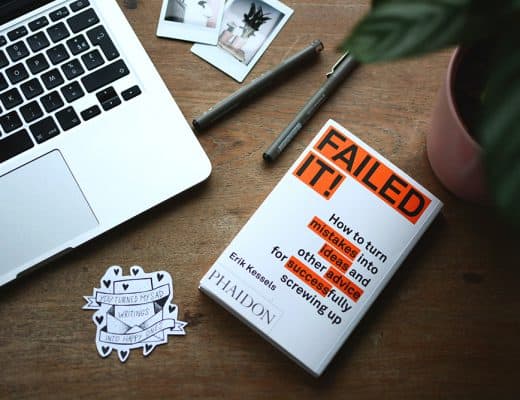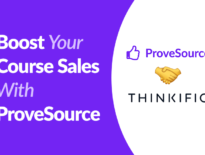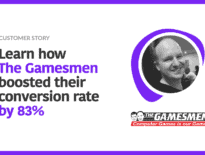We believe in validation (or invalidation) before execution.
Thinking about building your product MVP or checking the market potential? Here is how we did (and still do) it for the last 3 years.
But first, a little story on how it all started.
Build it and they will come?
We’ve started our company about 6 years ago, we called it Configo (Configuration + Startup fluff) and for the first year or so, we were so busy!
Busy building a product that no one wanted or needed. We fell victims to the builder/maker mindset of “build it and they will come”, will they though?
In our case, they didn’t, and since we have a product but no customers – we decided we need to do sales.
We tried selling it as a self service subscription SaaS for a few bucks a month.
A friend of ours, a long time founder, told us the formula is easy:
Count on a 3% conversion rate on each step of the funnel, do you want 1 paying customer with a funnel that looks like this: visitor -> signup -> payment funnel?
This is what you need:
1 paying customer = 33 signups = 1100 visitors.
Start driving the traffic, buddy.
We used Google Ads, Facebook Ads and pretty much any <company> Ads out there and we got the traffic alright, but no one was converting.
The red warning light should have been on by now, but we have a product, we can’t just dump it… So we figured if we can’t sell it to small businesses, we should sell to enterprises.
SaaS didn’t work? Go Enterprise!
If we can’t sell to the little guys, that’s because the product is too good for them. Let’s sell it to financial corporations like banks!
So we took up arms (and booths) and started cold reaching “Innvoation Managers” at banks. Messages became emails, emails became zoom (and webex bah!) and zoom became long flights to all over Europe.
Here’s the thing about enterprises – they never say “No”.
It’s always “Sounds interesting”, “Send us a deck” or “We will explore this again in 3 months”. You need to be good at selling, have a great product and a long runway if you want to go enterprise.
After maybe 1xx meetings, 3xx demos, thousands of emails and about 2.5 years of grind, we didn’t have another plan.
So it was time to “kill the baby” and drop the product.
This phase should probably be titled How not to build an MVP.
What should we do next?
Lean, Mean, Lead Machine
It’s January 2018 and we are two broken founders (so called entrepreneurs) who just want to build a business.
Here’s a cool idea, let’s take the “social proof hack” that booking.com uses and offer online businesses who can’t build it themselves.
Only this time around, we didn’t have any runway (we burnt our savings for 3 years). We had to do it fast and we did not have time to build anything. We had to get traction.
The idea was simple, make a mockup, setup a landing page and drive traffic.
The goal was even simpler, get 100 leads to signup to a non-existant product in 30 days or so.
Do whatever you must, send emails, send messages, post the product on reddit and even spend some money on ads. We assumed that if we get those leads – we can call it traction and the beginning of a customer base.
We wrote down an execution plan for those 30 days:
Recipe a.k.a. “System”
- Think of a concept and describe what the customer will get from your product. “Uber for face cream” is not a benefit, “Make your skin soft and beautiful from the comfort of your home” might make more sense.
- Think of a name (don’t spend more than 1 hour on this), buy a domain, design a simple logo (you know Fiverr? Oh lord, to this day ProveSource’s logo is font awesome “thumb-up”)
- A Simple HTML landing page (singular, not plural): WordPress, Carrd, Unicorn Platform are your friends.
- The page should put emphasis on the benefit from point #1, have some details about the features that make the benefit possible and add a visual mockup: Figma and Canva are useful for this.
- The page should have an email field and a signup button (bonus: add pricing), your visitor needs to be convinced he can start using your product.
Once the visitor signs up tell him “thank you, you’re on the waiting list”.
Save those emails in a spreadsheet, airtable, Slack message, whatever. - Add some fake social proof, like “join 250 users who already signed up”.
- Analytics, just so you can calculate visitor to signup conversion rate.
- Google Search Console, Social Media pages, etc, can wait…
- Google Ads, laser focused keywords, $100-$150 total budget.
- Post it on HackerNews, Producthunt, Reddit, etc.
- Deadline and a goal, you need to know when to end the experiment and how to determine if it’s a success or failure. Our goal was “100 signups in 1 month”.
- Bonus: add live chat widget to your website so you can talk to your visitors.
Apparently, there’s a term for this, Google “fake door test”.
Did you reach the deadline but not the goal? Great! Move on.
Goal accomplished (or better yet, crushed)? It’s to time to MVP.
The Ugly Duckling
If you’re proud of your product – That’s not good.
If you have all of the features you wanted – It’s bad.
If you’ve worked for more than 1-2 months on your MVP – It’s even worse.
Lean, broken and not too pretty is the name of the game, as the Zuck says: “move fast and break things”.
Think of the core feature, what would bring the most value to users and wouldn’t require a group of PhDs and AI researchers to build.
Do you need a password reset function? Nope.
Do you need enterprise level access control? Hell no.
Should you do things that don’t scale? Damn straight.
Here are a few funny stories that happened to us (it was terrifying back then):
- Users’ passwords were deleted once they logged in (so next time they couldn’t) and we didn’t have a “password reset” feature.
- We charged a customer’s card $1 x 100 in less than 1 minute because of a race condition in our code.
- An automated test dropped our production database 😱
Sell the Ugly Duckling
So you have an MVP product and a list of 100 users in the waiting list.
First, try to get at least a couple of those users to use your product.
In the meantime, keep pushing the product anywhere you can. If paid acquisition is not an option (bootstrapped, amiright?) send 50 emails and messages per day to anyone who your product might help.
Another channel that worked for us – do a lifetime deal.
Search for “Martech” Facebook group, AppSumo, Dealify and others.
The lifetime deals audience is savvy. They know value when they see it and they will buy (cheaply though). If you get these folks to buy your software for $39-$79 one time purchase, you probably have something that people need.
Doing $10k sales in 1 month can be addictive, but remember – recurring revenue is your fuel, lifetime deal sales… umm get you a car? or new tires maybe?
$1k MRR and Beyond
If you got to this point, congratulations, you’re in the club!
Just a joke, the grind only gets harder.
- Talk to your customers, fix bugs, improve your product.
- Onboarding, automation, education – help users make the most of your product.
- Build new features (but only if they’re good, not for the sake of developing).
- Build repertoire, make a name for yourself – best product and best support (and don’t sell it cheap)!
Our Examples
ProveSource
ProveSource was the first product that scaled past the MVP phase with this method. We bought a domain, made a simple landing page, spent $100 on Google Ads, posted on Producthunt and got 250 signups in one month. ProveSource is still growing and profitable. You can read more about it here.
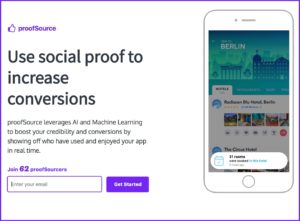

New Features
Whenever we want to build a new feature for ProveSource, we add an internal landing page to our dashboard, and wait for users to click that button. Here’s an example:
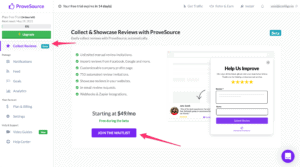

Fivesterr
Fivesterr was a simple idea (we thought it was brilliant at the time), a website builder/platform for Fiverr freelancers that automatically builds a portfolio website, with reviews, gig order page, etc.
We couldn’t get even 5 people to signup.
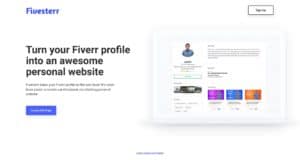

ChurnKit
ChurnKit was born from our own itch we wanted to scratch. A tool for SaaS companies to identify which of their customers stopped using their product, those who are… well, about to churn.
Quite a few people signed up for this one and we even started building an MVP. But technical issues (we’re not the best developers), privacy and other concerns made us stop.
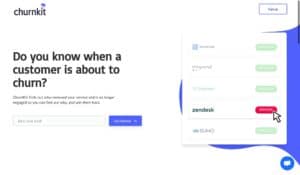

PurpleAds
PurpleAds, second to the house of Configo, is a simple, premium ad network.
Our customers at ProveSource wanted more traffic so they can get more social proof and more sales:
Traffic = Conversions + Sales = Revenue and Social Proof
So we built PurpleAds to help our users get more traffic and it’s been growing ever since.
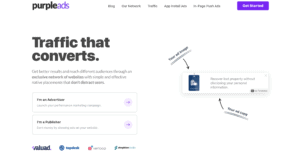

LinksCartel
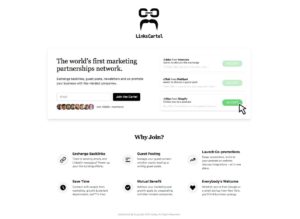

Our lawyer doesn’t like the word cartel, but we’re just playing around.
Our latest endeavour, still in the waitlist phase (as of April 2021).
We decided to test the waters for a link exchange / guest post / co-promotion social network (2015 buzz words).
If we haven’t built it yet, take a look at the recipe in action here.
Epilogue
If you’d ask me to summarize:
Start with the business, go get a dollar, a buck, a customer.
Also, I would say don’t do:
- Endless market research (with made up numbers)
- Competitor research (knowing the biggest 3 should be enough)
- Development plans
- Architecture
- Investor meetings
- Meet mentors, consultants, coachers
Next up on founder stories… hopefully – how we scaled to $2m ARR?




